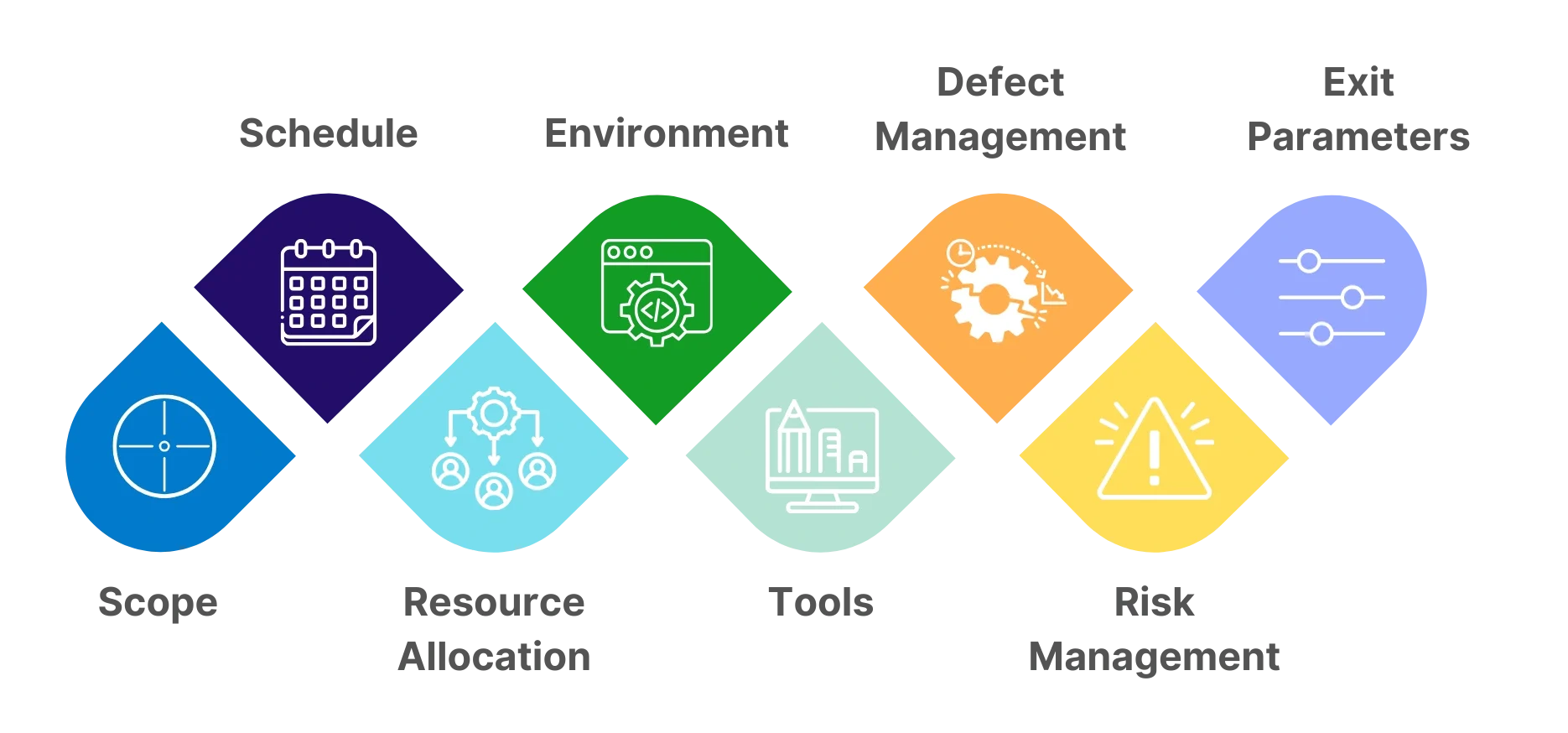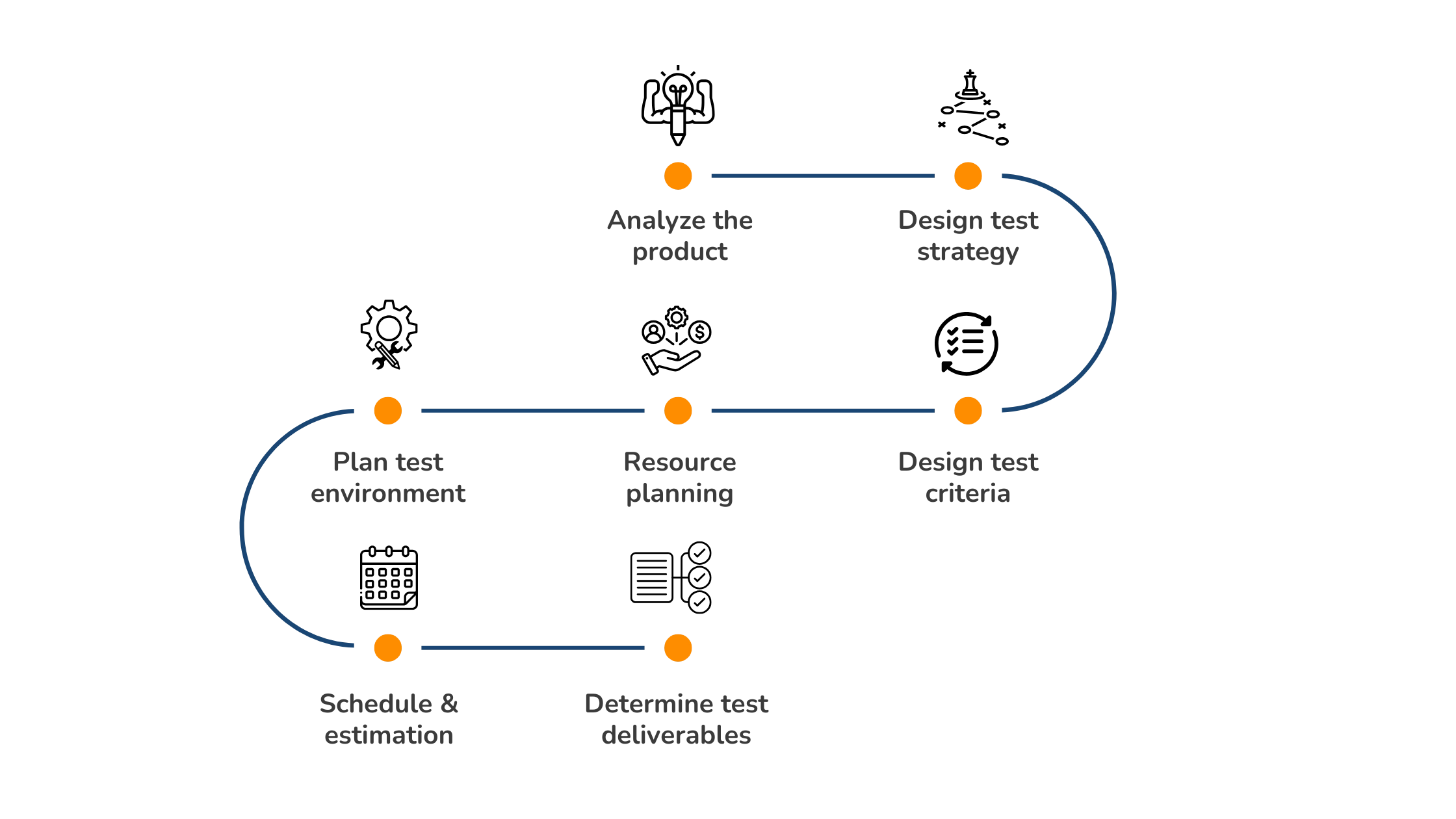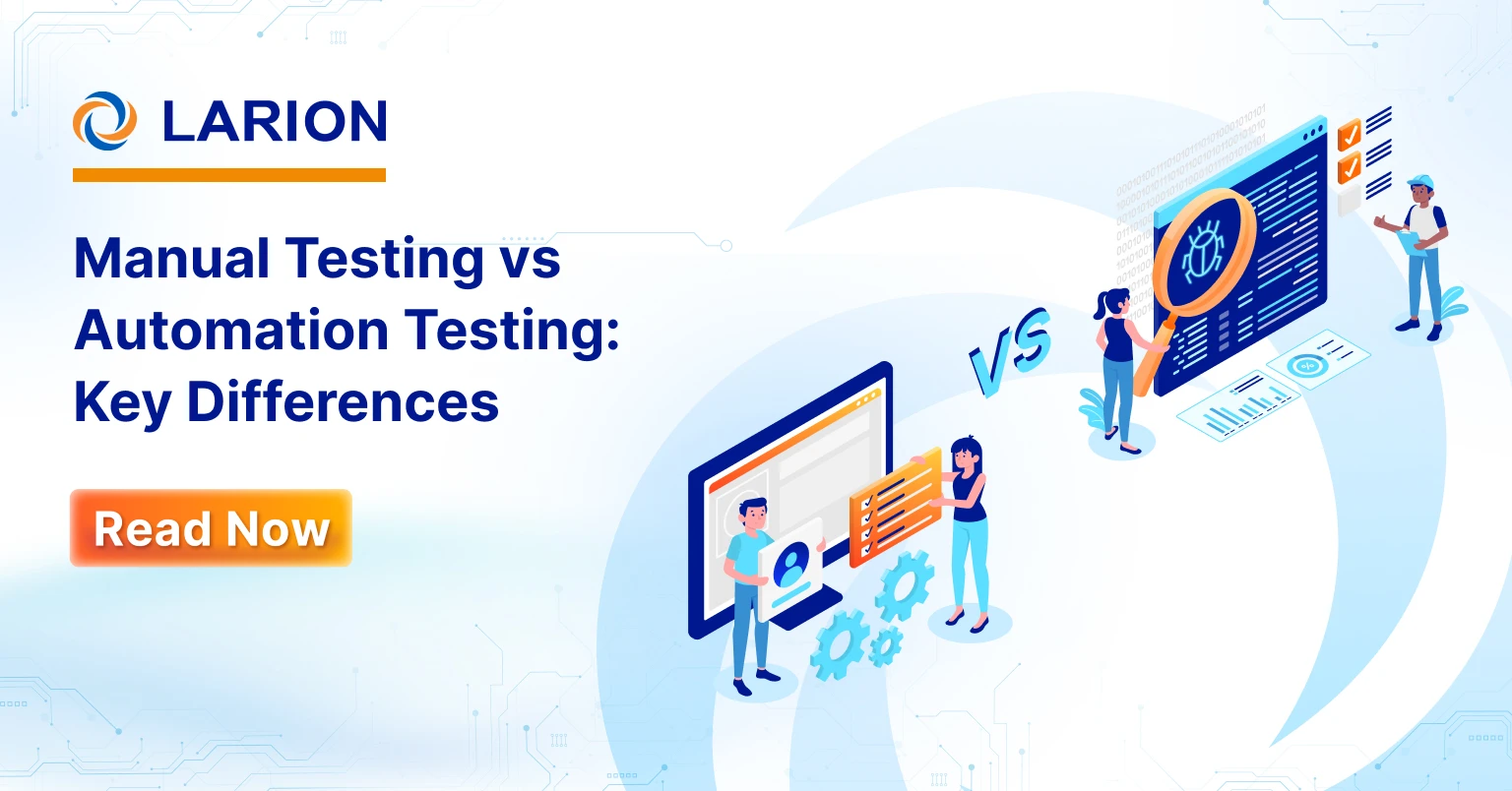
What’s more expensive than software testing? Releasing a product riddled with defects.
A solid software test plan helps prevent costly post-launch failures by ensuring structured, efficient, and comprehensive testing. It minimizes risks, optimizes resources, and aligns your team toward quality-driven development.
Whether you’re a startup or an enterprise, having a clear roadmap for testing means faster time-to-market, fewer customer complaints, and lower maintenance costs. Let’s explore how to craft a software test plan that saves time, cuts costs, and ensures smooth product releases
What is a test plan in software testing?
A software test plan is a structured document defining objectives, processes, and resources for a testing project. Acting as a blueprint for software testing, it ensures a systematic and organized approach.
A well-crafted test plan ensures that all stakeholders in the software development process clearly understand the testing objectives, timelines, and required efforts. It also guarantees that every testing aspect for each component is thoroughly addressed and systematically executed, enhancing result accuracy and reducing the likelihood of defects throughout the application’s lifecycle
Benefits of the software test plan
A software test plan ensures a structured and efficient testing process. Its key objectives include:
- Define clear testing goals: Identify what needs to be tested and ensure alignment with requirements using a software test plan template.
- Ensure comprehensive coverage: Cover functional and non-functional aspects to minimize risks and use a test plan template in software testing for consistency.
- Optimize resource allocation: Assign roles, tools, and schedules efficiently.
- Establish a clear timeline: Set milestones aligned with development cycles.
- Improve accuracy & efficiency: Standardize processes and enhance defect tracking.
- Minimize risks: Identify potential issues early and apply mitigation strategies.
- Enhance team communication: Provide clarity for stakeholders and ensure collaboration.
- Ensure compliance: Follow industry standards and regulatory requirements.
Types of software test plan
In software testing, different types of test plans are designed to address various aspects of the testing process. Here are the most commonly used ones

1. Master test plan
A high-level document that defines the overall testing approach for an entire project. It includes objectives, scope, methodologies, resources, and timelines, ensuring consistency across all testing activities.
2. Specific test plan
A specific test plan focuses on individual types of testing, such as load testing, performance testing, or security testing. It provides detailed guidelines and procedures to ensure that each aspect is thoroughly tested.
3. Phase test plan
Phase test plan rely on specific factors such as project requirements, specifications, or risks. For example:
- User acceptance testing is driven by user requirements to ensure the software meets end-user needs.
- System testing is guided by technical specifications to verify that each component of the system operates correctly.
Components of a software test plan

A well-structured test plan consists of several crucial components:
- Scope: Defines the objectives of the project and outlines user scenarios that will be tested. It may also indicate any scenarios or issues that are intentionally excluded.
- Schedule: Establishes the start dates and deadlines for testers to complete their assessments and deliver results.
- Resource allocation: Assigns specific testing tasks to designated testers, ensuring clarity in responsibilities.
- Test environment: Describes the setup, configuration, and accessibility of the testing environment.
- Testing tools: Lists the tools that will be used for executing tests, tracking bugs, and managing other testing-related activities.
- Defect management: Details the process for reporting issues, specifying who should receive bug reports and what supporting materials (such as screenshots, logs, or videos) should be included.
- Risk management: Identifies potential risks that may emerge during testing and highlights the risks associated with releasing the software without thorough evaluation.
- Exit criteria: Defines the conditions under which testing will conclude, providing expected outcomes that testers can use to assess overall software quality.
How to write a software test plan

1. Analyze the product
Before starting the testing process, it is essential to gain a deep understanding of the software, its purpose, and its functionality. A clear product comprehension helps define relevant test objectives and ensure comprehensive test coverage.
Steps to achieve this:
- Stakeholder discussions: Conduct interviews with clients, developers, and designers to gather insights.
- Document review: Examine project documentation, technical specifications, and user requirements.
- Product walkthrough: Explore the software to understand its features, user flow, and potential pain points.
2. Develop a test strategy
A strong test strategy helps you write a software test plan efficiently. It defines the testing approach, required resources, and testing schedule to align with project goals.
Key considerations:
- Types of testing: Choose appropriate testing methods.
- Resource allocation: Determine tools, team members, and infrastructure.
- Testing schedule: Outline timelines for different testing phases.
3. Define test objectives
Clearly defining test objectives ensures a structured, efficient, and goal-oriented testing process, leading to higher software quality and stability.
Examples of test objectives:
- Functional testing: Validate workflows, data processing accuracy, and system interactions.
- Usability testing: Ensure intuitive navigation and user-friendly interfaces.
- Security testing: Detect vulnerabilities and ensure compliance with data protection standards.
- Performance testing: Evaluate response time, scalability, and system throughput.
4. Define test criteria
Setting clear criteria ensures a software test plan has measurable success benchmarks before release.
Two main types of test criteria:
- Suspension criteria: Defines when testing should be paused due to critical defects or dependencies.
- Exit criteria: Specifies when testing is complete (e.g., 95% of test cases must pass, all critical defects must be fixed).
5. Resource planning
Proper resource planning is essential for executing a software test plan successfully.
Key aspects:
- Manpower allocation: Assign testers based on expertise in manual, automation, security, and performance testing.
- Tool selection: Choose relevant testing tools such as Selenium, Cypress, JMeter, OWASP ZAP, TestRail, or Jira.
- Equipment & infrastructure: Ensure access to test environments, devices, and network configurations.
6. Plan test environment
A well-structured test environment is critical for practical testing. It should replicate real-world conditions to ensure performance accuracy and software reliability.
Key components:
- Hardware & software tools: Select appropriate testing tools based on project requirements.
- System requirements: Define necessary OS, browsers, databases, and configurations.
- Network setup: Ensure the right topology, firewalls, and bandwidth conditions are in place.
7. Schedule and estimation
A clear testing schedule ensures timely execution without compromising software quality.
Key considerations:
- Number of tests: Estimate the test case volume needed for full coverage.
- Types of tests: Plan for different functional, usability, security, and performance tests.
- Communication channels: Establish effective collaboration among testers and developers.
8. Determine test deliverables
Test deliverables document progress, defects, and testing efficiency, ensuring transparency.
Common test deliverables include:
- Software test plan document: Defines strategy, scope, and schedule.
- Test cases & scripts: Detailed scenarios and steps for manual and automated tests.
- Defect reports: Logs identified bugs, severity, and resolution status.
- Test summary report: Final report summarizing test execution, outcomes, and key findings.
By following these steps and using a software test plan template, you can improve efficiency, reduce risks, and ensure software quality at every stage.
Sample Software Test Plan Document
| Component | Details |
|
Objectives |
The goal is to ensure the banking app’s core functionalities (account management, fund transfers, bill payments, and security measures) perform as expected while meeting performance, usability, and security compliance standards. Specific objectives include:
|
|
Approach |
The test strategy combines manual and automated testing.
|
| Scope |
In scope
|
|
Out of scope
|
|
|
Test Deliverables |
These deliverables will be shared bi-weekly with stakeholders and archived for future regression testing. |
|
Dependencies |
Contingency plan: Use mock services for API dependencies if unavailable |
| Test Environment |
|
| Risk Management |
Identified risks:
Mitigation strategies:
|
|
Schedule |
Timeline:
|
| Roles and Responsibilities |
|
Test plan vs test strategy
A software test plan focuses on the specifics of testing for a particular project, while a test strategy sets the overarching approach and principles for testing across projects or the entire organization.
Here’s an in-depth comparison of test strategy and test plan:
| Aspect | Test Plan | Test strategy |
| Definition |
A detailed document defining the scope, objectives, resources, and schedule for testing in a specific project. |
A high-level document outlining the overall testing approach, principles, and objectives for multiple projects or the entire organization. |
|
Objective |
Provides a structured, step-by-step plan for test execution in a project. |
Establishes a long-term vision for testing aligned with organizational goals. |
|
Scope |
Project-specific, focusing on execution details for a release or phase. |
Organization-wide or product-wide, ensuring consistency across projects. |
|
Types |
Includes unit, integration, system, UAT test plans, etc. |
Can follow different methodologies: analytical, methodical, reactive, regression-averse, etc. |
|
Audiences |
Primarily for project teams: testers, developers, managers, and stakeholders. |
Intended for test managers, senior QA personnel, and project stakeholders. |
|
Timing |
Developed after the test strategy is defined. |
Created early in the project lifecycle to define the testing framework. |
|
Content |
Includes objectives, test scope, resources, test cases, schedules, and execution details. |
Defines approaches, methodologies, tools, quality standards, and risk management. |
|
Focus |
Specific test activities and execution steps. |
Overall direction, methodologies, and best practices for testing. |
|
Risk Management |
May cover risk identification and mitigation for a project. |
Encompasses broader risk management strategies for testing consistency across projects. |
|
Document Type |
A standalone document for a specific project. |
Often a section within the test plan or a high-level organizational document. |
|
Definition Level |
Defined at the project level. |
Defined at an organizational level. |
|
Source Document |
Derived from the Software Requirement Specification (SRS). |
Based on the Business Requirement Specification (BRS). |
|
Prepared by |
Test Leads or Test Managers. |
QA/Test Managers or Business Analysts. |
| Development Stage | Created after requirement sign-off and before test execution. |
Finalized before test plans are developed to provide a testing framework. |
Conclusion
A well-structured software test plan ensures smooth testing, minimizing risks and improving team collaboration. Using a test plan template enhances clarity, saves time, and ensures consistency across different test types.
LARION optimizes this process with tailored testing solutions, structured software test plans, and expert guidance. Our software testing services streamline documentation, making test tracking and execution more efficient. Whether you need a test plan example or assistance in writing one, our specialists are here to help.
Ready to enhance your testing process? Contact LARION today for a free consultation.





